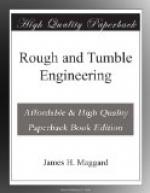between the pump and the water supply. It is
not absolutely necessary that the first check be a
vertical one, but a check of some kind must be so
placed. As the water is lifted up to the boiler
it is more convenient to use a vertical check at this
point. Just ahead and a few inches from the pump
barrel is a horizontal check valve. Following
the course of the water toward the point where it enters
the boiler, you will find another check valve.
This is called a “hot water check.” just
below this check, or between it and where the water
enters the boiler, you will find a stop cock or it
may be a globe valve. They both answer the same
purpose. I will tell you further on why a stop
cock is preferable to a globe valve. While the
cross head pumps may differ as to location and arrangement,
you will find that they all require the parts described
and that the checks are so placed that they bear the
same relation to each other. No fewer parts can
be used in a pump required to lift water and force
it against steam pressure. More check valves
may be used, but it would not do to use less.
Each has its work to do, and the failure of one defeats
all the others. The pump barrel is a hollow
cylinder, the chamber being large enough to admit the
plunger which varies in size from 5/8 of an inch to
I inch in diameter, depending upon the size of the
boiler to be supplied. The barrel is usually
a few inches longer than the stroke of the engine,
and is provided at the cross head end with a stuffing
box and nut. At the discharge end it is tapped
out to admit of piping to conduct water from the pump.
At the same end and at the extreme end of the travel
of the plunger it is tapped for a second pipe through
which the water from the supply reaches the pump barrel.
The plunger is usually made of steel and turned down
to fit snug in the chamber, and is long enough to play
the full stroke of engine between the stuffing box
and point of supply and to connect with the driver
on the cross head. Now, we will take it for
granted, that, to begin with, the pump is in good order,
and we will start it up stroke at a time and watch
its work. Now, if everything be in good order,
we should have good water and a good hard rubber suction
hose attached to the supply pipe just under the globe
valve. When we start the pump we must open the
little pet cock between the two horizontal check valves.
The globe valve must be open so as to let the water
in. A check valve, whether it is vertical or
horizontal, will allow water to pass through it one
way only, if it is in good working order. If
the water will pass through both ways, it is of no
account. Now, the engine starts on the outward
stroke and draws the-plunger out of the chamber.
This leaves a space in the barrel which must be filled.
Air cannot get into it, because the pump is in perfect
order, neither can the air get to it through the hose,
as it is in the water, so that the pressure on the
outside of the water causes it to flow up through
the pipes through the first check valve and into the
pump barrel, and fills the space, and if the engine
has a I2-inch stroke, and the plunger is I inch in
diameter, we have a column of water in the pump I2
inches long and I inch in diameter.




